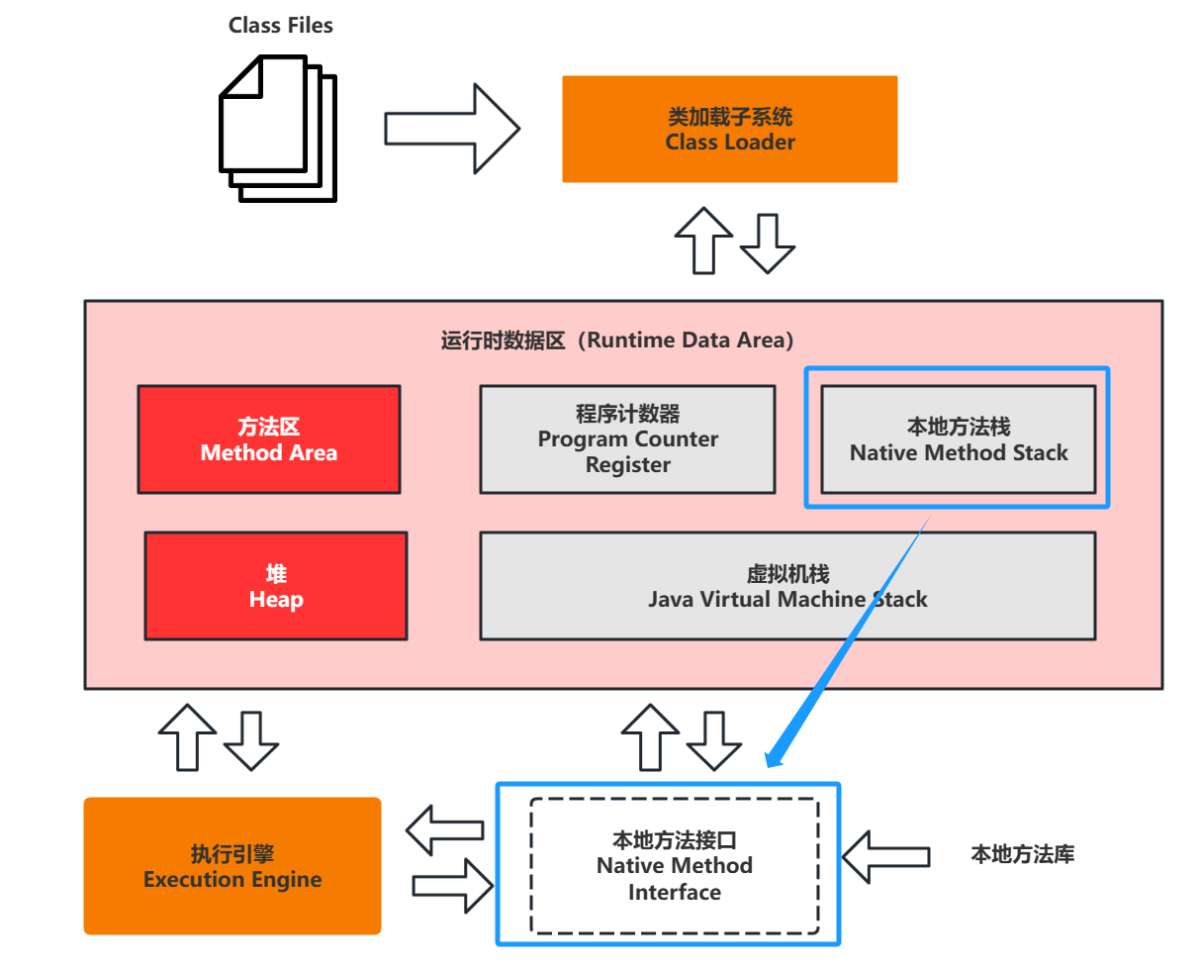7. 本地方法栈
- Java 虚拟机栈于管理 Java 方法的调用,而本地方法栈用于管理本地方法的调用。
- 本地方法栈,也是线程私有的。
- 允许被实现成固定或者是可动态扩展的内存大小。(在内存溢出方面是相同的)
- 如果线程请求分配的栈容量超过本地方法栈允许的最大容量,Java 虚拟机将会抛出一个
StackOverflowError异常。 - 如果本地方法栈可以动态扩展,并且在尝试扩展的时候无法申请到足够的内存,或者在创建新的线程时没有足够的内存去创建对应的本地方法栈,那么 Java 虚拟机将会抛出一个
OutOfMemoryError异常。
- 如果线程请求分配的栈容量超过本地方法栈允许的最大容量,Java 虚拟机将会抛出一个
- 本地方法是使用 C 语言实现的。
- 它的具体做法是 Native Method Stack 中登记 native 方法,在 Execution Engine 执行时加载本地方法库。
如 Thread 中的 start 方法,当我们调用 start 方法时会在我们的虚拟机栈中压入一个栈帧,而 start 方法又会调用 start0,start0 是一个本地方法,此时会在本地方法栈中压入一个栈帧。
public synchronized void start() {
/**
* This method is not invoked for the main method thread or "system"
* group threads created/set up by the VM. Any new functionality added
* to this method in the future may have to also be added to the VM.
*
* A zero status value corresponds to state "NEW".
*/
if (threadStatus != 0)
throw new IllegalThreadStateException();
/* Notify the group that this thread is about to be started
* so that it can be added to the group's list of threads
* and the group's unstarted count can be decremented. */
group.add(this);
boolean started = false;
try {
start0();
started = true;
} finally {
try {
if (!started) {
group.threadStartFailed(this);
}
} catch (Throwable ignore) {
/* do nothing. If start0 threw a Throwable then
it will be passed up the call stack */
}
}
}
private native void start0();

- 当某个线程调用一个本地方法时,它就进入了一个全新的并且不再受虚拟机限制的世界。它和虚拟机拥有同样的权限。
- 本地方法可以通过本地方法接口来访问虚拟机内部的运行时数据区。
- 它甚至可以直接使用本地处理器中的寄存器
- 直接从本地内存的堆中分配任意数量的内存。
- 并不是所有的JVM都支持本地方法。因为Java虚拟机规范并没有明确要求本地方法栈的使用语言、具体实现方式、数据结构等。如果JVM产品不打算支持native方法,也可以无需实现本地方法栈。
- 在Hotspot JVM中,直接将本地方法栈和虚拟机栈合二为一。
以下是 HotSpot VM 中关于本地方法栈规范的说明
An implementation of the Java Virtual Machine may use conventional stacks, colloquially called "C stacks," to support native methods (methods written in a language other than the Java programming language). Native method stacks may also be used by the implementation of an interpreter for the Java Virtual Machine's instruction set in a language such as C. Java Virtual Machine implementations that cannot load native methods and that do not themselves rely on conventional stacks need not supply native method stacks. If supplied, native method stacks are typically allocated per thread when each thread is created.
This specification permits native method stacks either to be of a fixed size or to dynamically expand and contract as required by the computation. If the native method stacks are of a fixed size, the size of each native method stack may be chosen independently when that stack is created.
A Java Virtual Machine implementation may provide the programmer or the user control over the initial size of the native method stacks, as well as, in the case of varying-size native method stacks, control over the maximum and minimum method stack sizes.
The following exceptional conditions are associated with native method stacks:
-
If the computation in a thread requires a larger native method stack than is permitted, the Java Virtual Machine throws a
StackOverflowError. -
If native method stacks can be dynamically expanded and native method stack expansion is attempted but insufficient memory can be made available, or if insufficient memory can be made available to create the initial native method stack for a new thread, the Java Virtual Machine throws an
OutOfMemoryError.
本地方法栈并不是虚拟机规范中要求的内容,所以在其他的虚拟机中并不一定有本地方法栈。方法区在 JDK 8 之后的版本改为了元空间(Meta Space)